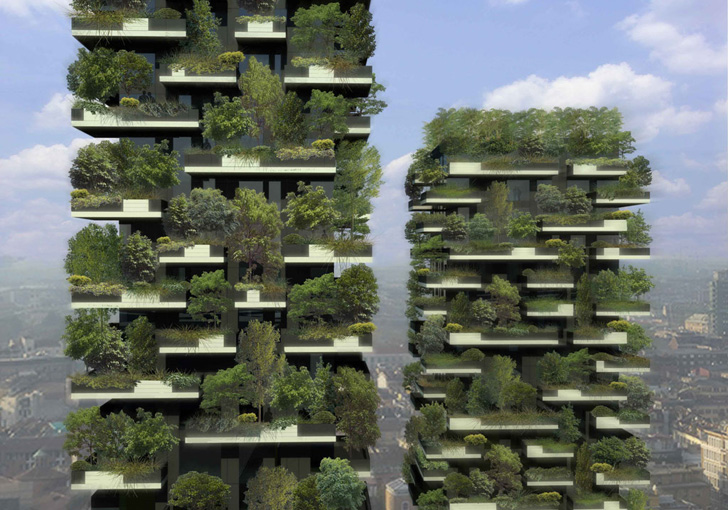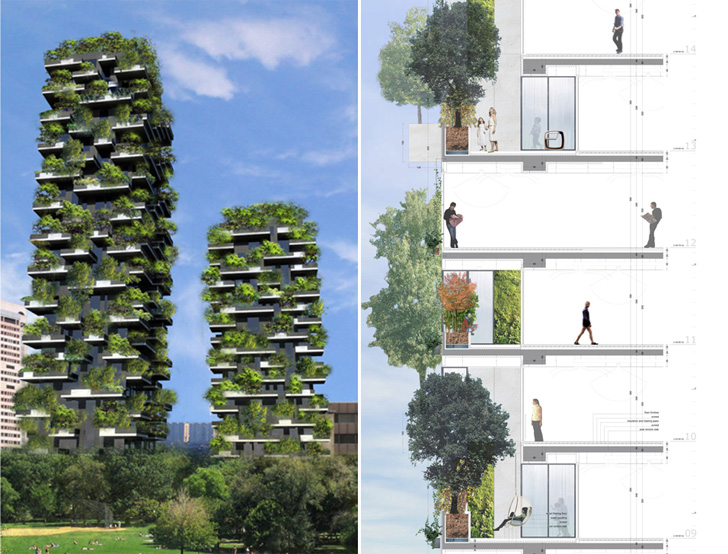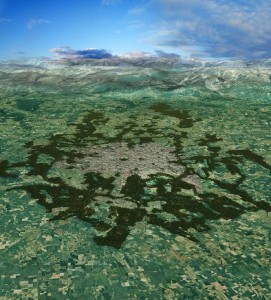Bosco Verticale or Vertical Forest, the first phase of re-envisioning of Milan, Italy, with an eye toward ecological urbanism, integrating tree and skyscraper, city and wild.


Bosco Verticale Under Construction, First Phase of Stefano Boeri‘s BioMilano
BioMilano would create “a more biodiverse metropolis,” intones architect, academic and former editor of design and architecture magazine Domus, Stefano Boeri. The six conceptual plans further advocate creation of a greenbelt around the city and restoring to community use 60 abandoned farms on the urban periphery. In Mr. Boeri’s words, the proposal includes:
Six ideas for a bio-diverse metropolis.
Six transitional states between the city, nature and agriculture.
Six energy sources for a new model of urban economics.
Eco-Cities: A Movement Toward Urban Greening
As scientists call for reductions in greenhouse gases to stave off climate change, cities could play a vital role in cutting carbon dioxide while generating their own energy, growing their own food, and devising mobility schemes to minimize sprawling development that consumes agricultural land, forests and natural open spaces. BioMilan purports to protect and enhance rural areas by regenerating central urban areas with higher density housing, close to offices and shops, with expanded natural and biological spaces.
httpvh://youtu.be/KlBSKSzaSqI
Boeri’s BioMilano vision, with Vertical Forest Towers and repurposed open spaces with agriculture and reforestation.
Thanks to a collaboration between architects, engineers, and botanists, this visionary reclamation of lost urban forests can inspire further interpretations throughout the world. Rotterdam architects MVRDV’s Torre Huerta in Valencia, Spain, a 21-storey social housing project planted like a fruit orchard, is another “flower tower” project with sufficient imagination to become a reality in a difficult market. A good sign that the Bosco Verticale towers are already mostly finished, as ambitious programs for eco-cities and mega-projects often fail to materialize.
Other visions become too ambitious for their own good, such as Donghan, an eco-city planned for near Shanghai, with its net-zero energy buildings, powered by on-site renewable sources, has not moved forward. This might be a net positive for the environment, considering it is yet another mega-city planned for China on open space and the country’s largest bird reserve. In India, a project to build the Mahindra World City as an eco-city seems to be falling short of that label as well.
BioMilano: Re-envisioning Urban Landscapes Using Green Technology
BioMilano envisions a comprehensive re-thinking of a sprawling city, moving beyond the superficiality of planting trees on a skyscraper, considering issues such as maximizing water and energy efficiency, reduced and reused building materials, public mobility, urban agriculture, and preserving open space. The program, from Boeri Studio, is as follows:
01. Vertical Forest: a tower with 900 trees
The Bosco Verticale (Vertical Forest) combines urban reforestation and vertical densification of nature and urbanity. Composed of two residential towers of 110 and 76 meters (26- and 18-storeys) high, it will host 900 trees, 5,000 bushes, and 11,000 plants on staggered, cantilevered balconies, made of reinforced concrete with 4.27-foot parapets. Covered in plant life, the building creates a balanced micro-climate and filters the urban dust and pollutants blowing in the brown haze of Milan’s benzene-laced air. Plants produce humidity, absorb CO2 and particulates, producing oxygen and protecting against radiation and noise pollution. This not only improves the quality of living spaces, but gives way to dramatic energy savings year round.


Plant irrigation will be supported through the filtering and reuse of the greywater produced by the building. Moreover, Aeolian and photovoltaic energy systems will further promote the tower’s self-sufficiency.
The design of the Bosco Verticale responds to both urban sprawl and the disappearance of nature from urban lives and landscapes. The architect notes that if the units were to be constructed unstacked as stand-alone units across a single surface, the project would require 50,000 square meters of land, and 10,000 square meters of woodland. Bosco Verticale is the first offer in his proposed BioMilano, which envisions a greenbelt created around the city to incorporate 60 abandoned farms on the outskirts of the city to be revitalized for community use.
02. Wood House: social housing and the tree cycle
The Wood House project aims to build low density and low cost social housing by using prefabricated forms of architecture and wooden panels recycled after conservation work on the trees which run along the Ticino River.
03. Courtyard Farms. A constellation of epicentres within systems of neighbourhood agriculture
The project for the restoration of 60 publicly owned and abandoned courtyard farms around Milan has its origins in the plan to create a new relationship between the city and new forms of agriculture. This kind of agriculture is more varied than in the past (fruit and vegetables, cereal crops, productive woods, bio-mass) and produces for the city as well as allowing for different kinds of research, training and work. Cities that rely on food being imported over long distances could find that it is expensive and leaves them vulnerable to shortages. Urban agriculture mitigates against threats to long-term food security.
04. Expo 2015: a global kitchen garden
The project for EXPO 2015 will create a vast global kitchen garden in an unused area to the northwest of Milan. Instead of the traditional national pavilions, each country invited to the expo will have a section of land on which to grow things, where it can display forms of bio-diversity, technologies, and possible solutions to problems linked to food and its supply. On the southern part of the site, big hot (and cold) houses will host plants and show off agricultural products linked to the world’s more extreme climates. After the Expo, Milan will be left with a large area which will be used to carry out research into the production and the representation of different forms of agriculture, seeding and food production. This will be the world’s first Agro-nutritional Scientific Park.
05. Metrobosco: a forest around Milan


The Metrobosco project will develop a circle of forests around Milan, integrating existing parks with agricultural areas and village open spaces which can provide more habitat close to the city for non-domestic wildlife common in the hinterland areas. Planned in cooperation with the Province of Milan and the Politecnico di Milano, three million trees will be planted, in cooperation with farmers and business owners who own the land, financed by the towns around the city.
06. Biological and plant decontamination of polluted urban areas
The cleaning up of ex-industrial areas and obsolete structures in the city through biological and plant cultivation creates new possibilities for public open space. Through the cultivation of polluted land, they can be cleaned-up and biomass is also created, and in this way the city can regain lost spaces which were seemingly lost forever.









Pingback: French-Designed Flower Towers Planned for Casablanca | WilderUtopia.com
I’m a researcher on roof Garden in Bangladesh. But due to information gap I can not do work on roof Garden. So if it is possible to get a training on roof Garden or visit your roof garden, it will be highly appreciated